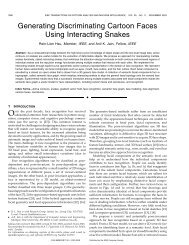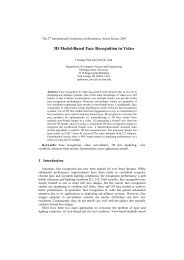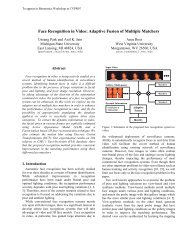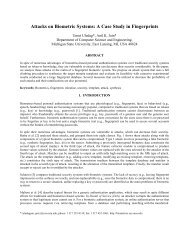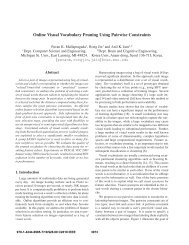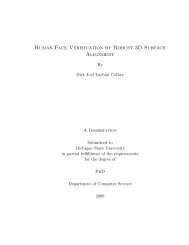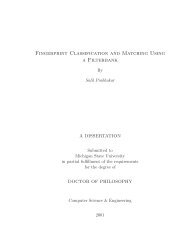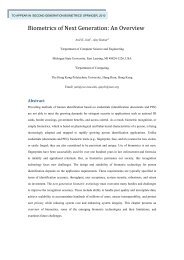- Page 1 and 2:
Face Detection and Modeling for Rec
- Page 3 and 4:
perimental results demonstrate succ
- Page 5 and 6:
To my parents; my lovely wife, Pei-
- Page 7 and 8:
for providing the range datasets; t
- Page 9 and 10:
4 Face Modeling 97 4.1 Modeling Met
- Page 11 and 12:
List of Figures 1.1 Applications us
- Page 13 and 14:
2.6 A breakdown of face recognition
- Page 15 and 16:
4.2 3D triangular-mesh model and it
- Page 17 and 18:
5.14 Fine alignment using geodesic
- Page 19 and 20:
Chapter 1 Introduction In recent ye
- Page 21 and 22:
(a) (b) Figure 1.1. Applications us
- Page 23 and 24:
(e) Figure 1.1. (Cont’d). (f) (a)
- Page 25 and 26:
esolutions and of poor quality (i.e
- Page 27 and 28:
can recognize known faces in carica
- Page 29 and 30:
the motivation for studies that att
- Page 31 and 32:
(a) Figure 1.10. Similarity of fron
- Page 33 and 34:
verify the face present in an image
- Page 35 and 36:
17 Figure 1.12. System diagram of o
- Page 37 and 38:
algorithm can also provide geometri
- Page 39 and 40:
commercial parametric face modeling
- Page 41 and 42:
1.5.1 Face Alignment Using 2.5D Sna
- Page 43 and 44:
1.5.3 Face Alignment Using Interact
- Page 45 and 46:
Using merely low-level features (e.
- Page 47 and 48:
such as eyes, mouth and face bounda
- Page 49 and 50:
can be applied to a 3D face model w
- Page 51 and 52:
Chapter 2 Literature Review We firs
- Page 53 and 54:
mation theory, geometrical modeling
- Page 55 and 56:
(e) (f) (g) (h) (i) (j) (k) (l) Fig
- Page 57 and 58:
esult in different recognition appr
- Page 59 and 60:
(a) (b) (c) Figure 2.2. Examples of
- Page 61 and 62:
(a) (b) (c) (d) Figure 2.4. Interna
- Page 63 and 64:
Figure 2.6. A breakdown of face rec
- Page 65 and 66:
2.3 Face Modeling Face modeling pla
- Page 67 and 68:
An advanced modeling approach which
- Page 69 and 70:
tionals to minimize, implementation
- Page 71 and 72:
are listed in Table 2.2. All of the
- Page 73 and 74:
low-level features can provide mean
- Page 75 and 76:
holistic 2D and geometrical 3D feat
- Page 77 and 78:
size) to generate potential face ca
- Page 79 and 80:
oundary. A face score is computed f
- Page 81 and 82:
normalized red-green (r-g) space [1
- Page 83 and 84:
(a) (b) Figure 3.3. The Y C b C r c
- Page 85 and 86: (a) Figure 3.5. 2D projections of t
- Page 87 and 88: 3.3 Localization of Facial Features
- Page 89 and 90: (a) (b) (c) Figure 3.9. Constructio
- Page 91 and 92: The eye map from the chroma is enha
- Page 93 and 94: mouth is performed within the face
- Page 95 and 96: Figure 3.12. Computation of face bo
- Page 97 and 98: center, and lengths of major and mi
- Page 99 and 100: segment. The other term favors an u
- Page 101 and 102: (a) (b) (c) (d) (e) Figure 3.15. Fa
- Page 103 and 104: (a) (b) (c) (d) (e) Figure 3.18. Fa
- Page 105 and 106: The number of false positives is al
- Page 107 and 108: (a) (b) (c) (d) Figure 3.20. Face d
- Page 109 and 110: Figure 3.22. Face detection results
- Page 111 and 112: Figure 3.22. (Cont’d). 93
- Page 113 and 114: 3.5 Summary We have presented a fac
- Page 115 and 116: Chapter 4 Face Modeling We first in
- Page 117 and 118: and nose in frontal views), and bec
- Page 119 and 120: 4.3 Facial Measurements Facial meas
- Page 121 and 122: 4.4 Model Construction Our face mod
- Page 123 and 124: a feature-dependent decay factor. F
- Page 125 and 126: is to find appropriate external ene
- Page 127 and 128: (a) (b) (d) (e) (f) Figure 4.11. Te
- Page 129 and 130: Chapter 5 Semantic Face Recognition
- Page 131 and 132: (a) (b) (c) Figure 5.1. Semantic fa
- Page 133 and 134: of Fourier series truncation. In ad
- Page 135: ponent color. The semantic facial s
- Page 139 and 140: (a) (b) (c) (d) Figure 5.7. Coarse
- Page 141 and 142: In the Baysian framework, given an
- Page 143 and 144: edge map; hence it requires a clean
- Page 145 and 146: shows examples of mouth energies. F
- Page 147 and 148: [ ( ∂Φ ∂t =∇Φ µ 1 div(g
- Page 149 and 150: (a) (b) (c) (d) (e) (f) Figure 5.14
- Page 151 and 152: y the reliability of component matc
- Page 153 and 154: tation, face size, and lighting con
- Page 155 and 156: (a) (b) (c) (d) Figure 5.18. Exampl
- Page 157 and 158: (a) (b) (c) (d) (e) (f) (g) (h) (i)
- Page 159 and 160: (a) (b) (c) (d) (e) (f) (g) Figure
- Page 161 and 162: 5.6 Summary For overcoming variatio
- Page 163 and 164: such vision-based systems are (i) d
- Page 165 and 166: 6.2 Future Directions Based on the
- Page 167 and 168: (a) (b) (c) (d) Figure 6.2. An exam
- Page 169 and 170: • Non-frontal training views: Acc
- Page 171 and 172: Appendices
- Page 173 and 174: ⎡ ⎤ ⎡ ⎤ ⎡ ⎤ ⎡ ⎤ Y
- Page 175 and 176: and are shown as blue-dashed lines
- Page 177 and 178: adius of a cluster ‘i’ w.r.t. a
- Page 179 and 180: Appendix C Image Processing Templat
- Page 181 and 182: considering pixel classes as voxel
- Page 183 and 184: gray8imageA(120,120) = 200; // Asse
- Page 185 and 186: Bibliography [1] Visionics Corporat
- Page 187 and 188:
[32] L. Wiskott, J.M. Fellous, N. K
- Page 189 and 190:
[59] M. Grudin, “On internal repr
- Page 191 and 192:
[84] M. Abdel-Mottaleb and A. Elgam
- Page 193 and 194:
[113] B. Kim and P. Burger, “Dept
- Page 195 and 196:
[141] M.D. Adams and F. Kossentini,
- Page 197 and 198:
[169] P.T. Jackway and M. Deriche,



